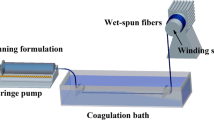Abstract
The aim of this study is to (1) find out the optimum post-thermal treatment temperature by observing the electrical resistance changes of the poly(3,4-ethylenedioxythiophene):poly(styrenesulfonate)(PEDOT:PSS) impregnated specimens, (2) examine the surface changes of the PEDOT:PSS impregnated specimens with post-thermal treatment temperature, (3) analyze the effects of the post-thermal treatment on the structural change of the PEDOT:PSS impregnated specimens as the thermal treatment temperature increased. PEDOT:PSS solution (aqueous dispersion, 1.3 wt%) was used in this study to impart the electrical conductivity to the polyurethane (PU) nanoweb. Post-thermal treatments carried out on PU nanoweb in the temperature range of 60-120°C. The results showed that the linear, sheet and specific resistance of the specimens decreased as the post-thermal treatment temperature increased. The highest electrical conductivity was 5.56 S/cm (P120) and the lowest was 0.53 S/cm (UT). FE-SEM images show that PU nanoweb was uniformly and successfully impregnated with PEDOT:PSS. According to the result of raman spectra indicates an effect of the post-thermal treatments on the structural change of the PEDOT chains, which suggests an electrical resistance change of specimens. It was found that the optimum post-thermal treatment conditions are 120°C and 15 minutes with impregnating methods.
Similar content being viewed by others
References
G. Cho, H. W. Jeong, K. H. Song, Y. A. Kwon, and S. J. Yoo, “New Apparel Materials”, Revised Edition, Gyomoon, Seoul, 2018.
E. Jang, I. Kim, E. Lee, and G. Cho, Sci. Emot. Sensibil., 20, 89 (2017).
G. Cho, “New Development in Textiles”, Revised Edition, Sigmapress, Seoul, 2006.
G. Cho, Y. J. Yang, and M. S. Sung, Fashion Text. Res. J., 10, 1 (2008).
S. Seyedin, J. M. Razal, P. C. Innis, A. Jeiranikhameneh, S. Beirne, and G G. Wallace, ACS Appl. Mater. Interfaces, 7, 21150 (2015).
J. P. Wang, P. Xue, and X. M. Tao, Mater. Sci. Eng. A., 528, 2863 (2011).
E. Jang, H. Liu, and G. Cho, Tex. Res. J., doi:10.1177/ 0040517519844604 (2019).
E. Lee and G. Cho, Text. Res. J., doi: 10.1177/ 0040517518805382 (2019).
E. Lee and G. Cho, Smart Mater. Struct., doi:10.1177/0040517518805382 (2019).
I. Kim, E. G. Lee, E. Jang, and G. Cho, Tex. Res. J., doi:10.1177/0040517517697647 (2017).
I. Kim, E. G. Lee, E. Jang, S. J. Lee, J. M. Myoung, and G. Cho, “The Proceedings of the Fiber Society 2016 Fall Conference”, 2016.
Y. Ding, W. Xu, W. Wang, H. Fong, and Z. Zhu, ACS Appl. Mater. Interfaces, 9, 30014 (2017).
S. W. Park, T. H. Oh, J. S. Hwang, and Y J. Lee, Fiber. Polym., 17, 1171 (2016).
X. Wang, M. Q. Ge, and G Y. Feng, Fiber. Polym., 16, 2578 (2015).
M. Åkerfeldt, M. Strâât, and P. Walkenström, Tex. Res. J., 83, 618 (2013).
J. D. Ryan, D. A. Mengistie, R. Gabrielsson, A. Lund, and C. Müller, ACS Appl. Mater. Interfaces, 9, 9045 (2017).
M. D. Irwin, D. A. Roberson, R. I. Olivas, R. B. Wicker, and E. MacDonald, Fiber. Polym., 12, 904 (2011).
J. Ouyang, C. W. Chu, F. C. Chen, Q. Xu, and Y. Yang, Adv. Funct., 15, 203 (2005).
I. Cruz-Cruz, M. Reyes-Reyes, M. A. Aguilar-Frutis, A. G. Rodriguez, and R. Löpez-Sandoval, Synth. Met., 160, 1501 (2010).
C. Sriprachuabwong, C. Karuwan, A. Wisitsorrat, D. Phokharatkul, T. Lomas, P. Sritongkham, and A. Tuantranont, J. Mater. Chem., 22, 5478 (2012).
Y. Ding, M. A. hivernale, and G A. Sotzing, ACS Appl. Mater. Interfaces, 2, 1588 (2010).
T. Takano, H. Masunaga, A. Fujiwara, H. Okuzaki, and T. Sasaki, Macromolecules, 45, 3859 (2012).
J. Zhou, D. H. Anjum, L. Chen, X. Xu, I. A. Ventura, L. Jiang, and G. Lubineau, J. Mater. Chem. C., 2, 9903 (2014).
Acknowledgments
This research was supported by the National Research Foundation of Korea (NRF) funded by the Ministry of Education, Science and Technology (No. NRF-2019R1F1A1060955) and the Brain Korea 21 Plus Project of Dept. of Clothing and Textiles, Yonsei University in 2020.
Author information
Authors and Affiliations
Corresponding author
Rights and permissions
About this article
Cite this article
Cho, Hs., Jang, E. & Cho, G. Characterization of PEDOT:PSS Impregnated Polyurethane Nanoweb with Post-Thermal Treatment for E-Textiles. Fibers Polym 21, 965–969 (2020). https://doi.org/10.1007/s12221-020-9986-5
Received:
Revised:
Accepted:
Published:
Issue Date:
DOI: https://doi.org/10.1007/s12221-020-9986-5




